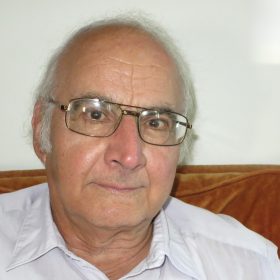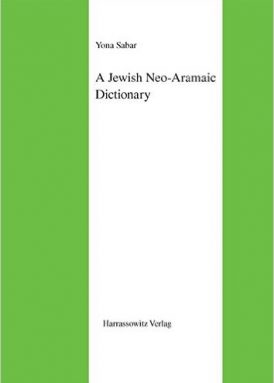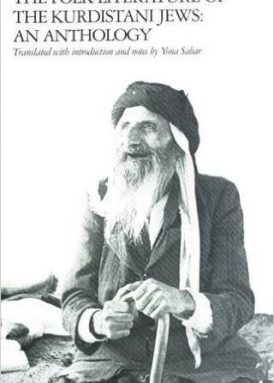Education
PhD, Near Eastern Languages and Literatures, Yale (1970)
BA, Hebrew and Arabic, Hebrew University, Jerusalem (1963)
Publications
Articles
Articles
- 121 “A Traveller Report on Kurdish Jews Localities in Kurdistan and Diasporas by a Kurdish Rabbi from 1932,” (Hebrew) Language Studies XVII-XVIII, Aharom Maman Festschrift, Jerusalem, 2017, Pp. 455-500.
- “Burying MY Mother Tongue,” The Jewish Week/Text and Context, 4/27/2009 (OnLine: http://www.thejewishweek.com/viewArticle/c228_a15559/Special_Sections/Text_Context.html
- Hakham ‘Alwan Avidani ‘s Unique Neo-Aramaic Translations of Biblical and Other Traditional Texts,” Studies in Hebrew, Aramaic and Jewish Languages Presented to Moshe Bar-Asher [Director of the Hebrew Language Academy], vol. II Rabbinic Hebrew and Aramaic (2008), pp. 435-52.
- “Agonies of Childbearing and Child Rearing in Iraqi Kurdistan, A Narrative in Jewish Neo-Aramaic and its English Translation,” Studies in Semitic and General Linguistics in Honor of Gideon Goldenberg, ed. Tali Bar and Eran Cohen (AOAT 334), Münster, 2007, pp. 107-145
- “Yona Gabbay, A Jewish Peddler’s Life Story from Iraqi Kurdistan, As Narrated by him in his Aramaic Dialect of Zakho (Four Episodes),” Mediterranean Language Review 16 (2005), pp. 167-220.
- “Some Comparative Observations on the Lexicons of Nerwa Texts in Jewish Neo-Aramaic and the Neo-Syriac Poems of Alqosh and Telkepe, both from ca. the 17th Century and Both from Kurdistan, Northern Iraq, ”Studi Afroasiatici IX Incontro Italiano di Linguistica Camitosemitica, A cura di Alessandro Mengozzi, Milano, 2005, pp. 391-96.
- “Torah in the Mouth and Torah in the Heart: How Judaism was Transmitted in a Minimally-Literate Near Eastern Jewish Community,” Queens College Journal of Jewish Studies, Spring 2005 vol. VII, pp. 67
- “The Multiple Faces of Eve :The Images of Woman in the Folk Literature of A Near Eastern Jewish Community,” International Sephardic Journal 2/1 (2005): 146-157.
- “Proper Names and Family Names among the Jews of Iraq,” Nehardea 14, 2003: pp. 11-12.
“A Comparative Study of the Hebrew Elements in the Judeo-Arabic Dialects of Iraq with those in the Jewish Neo-Aramaic Dialects,” In Y. Avishur Festschrift, Tel-Aviv, 2004, pp. 261-294
- “Mi Kamokha – A Purim Poem in the Neo-Aramaic Dialect of Birdug (Iran, 1780)”, Ben ‘Ever le-‘Arav, vol. 3 (2004), pp. 95-120.
“Names and Nicknames among various Jewish Communities,” Hado’ar spring 2003, 67-69.
- “Targumic Influence On Jewish Bible Translations In Neo-Aramaic,” Aramaic Studies 1/1 ((2003), Pp. 55-65.
- “Aramaic, Once An International Language, Now On The Verge Of Expiration: Are The Days Of Its Last Vestiges Numbered” at When Languages Collide: Perspectives on Language Conflict, Language Competition, and Language Coexistence, edited by: Brian D. Joseph, Johanna DeStefano, Neil G. Jacobs, and Ilse Lehiste, The Ohio State University Press, 2003, pp. 222-234.
- “Ma Nishtana: A Comparison of the Neo-Aramaic Translations and the Hebrew Text of Two Kurdistani Passover Haggadot: A Historical-Linguistic Study, Including Remarks on Kurdistani Passover Folklore,” Leshonenu 64 (5762 [=2002]), pp. 73-91, and Leshonenu 65 (2002), pp. 95-96.
- “The Story of Brothers Ali and Amar in the Jewish Dialect of Zakho. Based on Albert Socin’s Text from 1870, transcribed anew as if it were told ca. 1950, and emphasizing the linguistic changes that occurred in the dialect since Socin’s time,” Festschrift für Otto Jastrow zum 60. Geburstag, ed. Werner Arnold, Wiesbaden, 2002, pp. 613-627.
- “Parallel Patterns of Development in Jewish Neo-Aramaic and Modern Israeli Hebrew,” Leshonenu 62 (1999), pp. 334-344.
- “Migdal Babel: The Linguistic Heritage of Iraq,” Yosef Hayim 4 (2000):3-4
- “The Neo-Aramaic Pentateuch –A Summary of Findings,” Pe’amim 83 (2000):108-117.
- “The Hebrew Elements in Written Jewish Neo-Aramaic Texts (in Manuscripts and Printed Editions),” Vena Hebraica in Judaeorum Linguis, ed. Sh. Morag, et al., Milano, 1999: 387-397.
- “Family and community Values as Reflected in Proverbs of the Jews of Iraq,” Yosef Hayim 3, 1998, p.2
“The Story of Balaam and His She-Ass (Numbers, Chapter 22) in four Neo-Aramaic Dialects: A Comparative Study of the Translations,” in Humanism,Culture and Language in the Middle East, Studies in Honor of Georg Krotkoff, ed. A. Afsaruddin and A.H.M.Zahniser, Winona Lake, 1997, pp. 301-317.
“The Famous Barzani Family of Rabbis of Kurdistan,” Kurdistan Times, vol. 4 (1995), pp. 186-188.
- “Christian Neo-Aramaic Love Songs in a Jewish Manuscript,” Israel Oriental Studies Vol. 16, Studies in Modern Semitic Languages, 1996, pp. 85-91.
- “The Christian Neo-Aramaic Dialects of Zakho and Dihok: Two Text Samples,” JAOS 115/1 (1995), pp. 33-51 (18 pages).
“Reflections of Social Values in the Folk Literature of Kurdistani Jews” in History and Creativity in the Sephardi and Oriental Jewish Communities, ed. T. Alexander et al. (Winter 1995) pp. 117-146
- “Iraqi Kurdistan after the Gulf War: Christian and Jewish Vestiges,” Kurdistan Times 3 (12/1993), pp. 139-145 (6 pages). (A summary in Near Eastern Center [UCLA] Newsletter 13/2 (1993), pages 6-7.
- “Today Palestine, tomorrow Kurdistan?” Jerusalem Post 10/19/93, Daily Bruin 10/26/93
- “Tafsir ıir Ha∫∫irim: An old Neo-Aramaic version of the Targum on Canticles,” Maarav 8 (1992) pp.303-317 (14 pages). A much modified version of the Introduction to my book number 43.
- “A Folktale and Folk Songs in the Christian Neo-Aramaic Dialect of Tel-Kepe (Northern Iraq),” Semitica Serta Philologica Constantino Tsereteli dicata, ed.R. Contini, et al., Torino, 1993 pp. 289-298 (10 pages).
- “Back to Kurdistan,” Yediot Aharont, weekend supplement 7 Days, 10/30/1992, pp. 19-22 (4 pages). A shorter version appeared in Ha’am (UCLA), 3/13/1993, pp. 8-9, 13-14.
- “The Hebrew Bible Vocabulary as Reflected through Traditional Oral Neo-Aramaic Translations,” Semitic Studies in honor of W. Leslau, ed. A.S. Kaye, Vol. II, (Wiesbaden, 1991), pp. 1385-1401 (17 pages).
- “On the Nature of the Oral Translations of the Book of Exodus in Neo-Aramaic,” Maarav Vols. 5-6 (1990), pp. 311-317 (7 pages).
- “General European Loanwords in the Jewish Neo-Aramaic Dialect of Zakho, Iraqi Kurdistan,” Studies in Neo-Aramaic ed. W. Heinrichs, Atlanta, 1990, pp. 53-66 (14 pages).
- “Studies of the Folklore, Ethnography and Literature of Kurdistani Jews: An Annotated Bibliography,” Jewish Folklore and Ethnology Review Vol. II, No. 1-2 (1989), pp. 35-38 (4 pages).
- “Substratal and Adstratal Elements in Jewish Neo-Aramaic,” Studia Linguistica et Orientalia Memoriae Haim Blanc Dedicata ed. P. Wexler et al, Wiesbaden, 1989, pp. 264-276 (13 pages).
- “The Neo-Aramaic Dialects and the Other Languages Spoken by the Jews of Kurdistan,” Studies in Jewish Languages ed. M. Bar-Asher, Jerusalem, 1988, pp. 87-111 (15 pages).
- “The Arabic Elements in the Jewish Neo-Aramaic Texts of Nerwa and ‘Amadiya, Iraqi Kurdistan,” Journal of American Oriental Society 104 (1984) pp. 201-211 (11 pages).
- “The Quadriradical Verb in Eastern Neo-Aramaic Dialects,” the Journal of Semitic Studies 27/2 (1982), pp. 149-176 (28 pages)
- “Two Midrashic Commentaries to Jeremiah 8:13 – 9:23 in the Neo-Aramaic Dialects of Zakho and Amidya,” in Aramaeans, Aramaic and the Aramaic Literary Tradition, ed. Michael Sokoloff, Bar-Ilan University Press, 1983, pp. 11-41 (30 pages)
- “A Midrashic Commentary on Isaiah 10:32 – 12:6 in the Neo-Aramaic of the Kurdish Jews,” Studies in Aggadah and Jewish Folklore (Folklore Research Center) VII, ed. I. Ben-Ani, J. Dan, Jerusalem, 1983, pp. 317-336, 123 (20 pages)
- “The Literary Creativity of Kurdistani Jews,” Pe’amim 13 (1982) pp. 57-70 (13 pages); Hebrew translation of Appendix in #15.
- “Loyalty and Deviation in the Jewish Neo-Aramaic Translations of the Bible,” Le∫onenu 46 (1982/5742), pp. 124-140 (16 pages)
- “Legend vs. Reality: An Analysis and Comparison of Folktales about the Rabbis of Kurdistan with Documents Written by them or their Contemporaries,” The Sephardi and Oriental Jewish Heritage, ed. I. Ben-Ami, Jerusalem, 1982, pp. 287-296 (9 pages)
- “A Midrashic Commentary on the Book of Jonah in the Neo-Aramaic of the Jews of Kurdistan,” Jewish Thought in Islamic Lands, ed. M. Zohory, Jerusalem, 1981, pp. 131-143 (13 pages)
- “On the History of the Jews in Kurdistan,” Jews of Kurdistan: Way of Life, Tradition and Art, Israel Museum, Jerusalem 1981-82, pp. 16-41, 266-269 (29 pages); also appeared in Hamvaker, April 13, 1984, pp. 44-45 (2 pages), and April 27, 1984, p. 27 (1 page)
- “Qistit Hanna: A Neo-Aramaic Rhymed Legend on the Martyrs Hanna and Her Seven Sons,” Pe’amim (Ben-Zvi Institute, Israel) 7 (1981), pp. 83-99 (17 pages)
- “From Tel-Kepe (A Pile of Stones) in Iraqi Kurdistan to Providence, Rhode Island: The Story of a Chaldean Immigrant to the U.S.A in 1927,” in The Journal of American Oriental Society, 98/4 (1978) pp. 410-415 (6 pages)
- “Multilingual Proverbs (Neo-Aramaic, Kurdish, Arabic) in the Neo- Aramaic Dialect of the Jews of Zakho,” International Journal of Middle East Studies, 9 (1978) pp. 215-235 (21 pages)
- “Kurdistani Realia and Attitudes as Reflected in the Midrashic-Aggadic Literature of the Kurdish Jews,” Studies in Jewish Folklore, ed. F. Talmage, Cambridge, 1980, pp. 287-296 (10 pages); an abstract appeared in the Association for Jewish Studies, Newsletter, 20 (1977), pp. 9-10 (2 pages)
“Jews Among Arabs,” a review of three books written by Oriental Jews on Oriental Jews, HA’AM (March 9, 1976) p. 5 (one page)
- “Lel-Huza: Story and History in a Cycle of Lamentations for the Ninth of Ab in the Jewish Neo-Aramaic Dialect of Zakho, Iraqi Kurdistan,” Journal of Semitic Studies, 22 (1976) pp. 138-162 (24 pages)
- “The Impact of Israeli Hebrew on the Neo-Aramaic Dialect of the Kurdish Jews of Zakho: A Case of Language Shift,” Hebrew Union College Annual, 46, Centennial Issue (1975) pp. 489-508 (20 pages)
- “The Hebrew Elements in the Neo-Aramaic Dialect of the Jews of Azerbaijan,” Le∫onenu, 39 (1975) pp. 272-294 (23 pages)
- “Kurdish Refugees from Iraq in Iran,” Yedi’ot Aharonot (Israeli Daily) (August 3, 1975) pp. 20-21 (2 pages)
- “First Names, Nicknames and Family Names Among the Jews of Kurdistan,” The Jewish Quarterly Review, 65/1 (1974) pp. 43-51 (9 pages)
- “Nursery Rhymes and Baby Words in the Jewish Neo-Aramaic Dialect of Zakho (Iraq),” Journal of the American Oriental Society, 94 (1974) pp. 329-336 (8 pages)
- “The Hebrew Elements in the Neo-Aramaic Dialect of the Jews of Zakho in Kurdistan,” Le∫onenu, 38 (1974) pp. 206-219 (14 pages)
“Isolated Community Becomes Part of Israel,” HA’ AM (UCLA), 3/4 (December 5, 1973) p. 5 (one page)
- “The Jews of Kurdistan,” The Kurdish Journal, 5/1-2 (June 1968) pp. 20-22 (3 pages)
- “Tafsirim (Commentaries) of the Bible and Hymns in the Neo-Aramaic of the Jews of Kurdistan,” Sefunot 10 (1965) pp. 337-412 (75 pages)
- “Belief in Demons and Evil Spirits Among the Jews of Kurdistan,” Yeda-’Am, Volume 8, #26 (1962) pp. 27-28 (2 pages)
Review Articles
- A Neo-Aramaic Dialect of Kurdistan, Text, Grammar and Vocabulary, by G. Krotkoff, New Haven, 1982. Mediterranean Language Review 10 (1998):197-209 (12 pages)
- A review article of Y. Avishur, The Folktales of Iraqi Jews (Haifa, 1992,) in Pe’amim, Studies in Oriental Jewry, 56 (1993), pp. 145-149 (5 pages).
- A Review-Article of: I. Avinery, The Aramaic Dialect of the Jews of Zakho, Jerusalem, 1988, JAOS Vol. 111, No. 3 (1991), pp. 653-656 (4 pages).
Research Books
- Jewish Neo-Aramaic Translations (Tafsirs) of Hebrew and Aramaic Liturgical Poems (1650-1950): A Critical Edition, Jerusalem (HUP), 2009, 440pp.
The Five Scrolls in Jewish Neo-Aramaic Translations, Dialects of ‘Amidya, Dihok, and Urmia, a Critical Edition, Based on Recordings and Manuscripts, etc., (Hebrew University Jewish Oral Tradition Center, Edah ve-Lashon # 26,) Jerusalem 2006.
- Jewish Neo-Aramaic Dictionary, based on old manuscripts, Bible translations, recorded folktales, and diverse registers of everyday speech, Wiesbaden (Harrassowitz, Semitica Viva Series #28), 2002.
- The Book of Deuteronomy in Neo-Aramaic, in the Dialect of the Jewish Community of Zakho, Including selected Texts in Other Neo-Aramaic Dialects and a Glossary. Jerusalem, The Hebrew University, Language Traditions Project, 159+47 pages (1994).
- The Book of Numbers in Neo-Aramaic in the Dialect of the Jewish Community of Zakho, Including selected Texts in Other Neo-Aramaic Dialects and a Glossary. Jerusalem, The Hebrew University, Language Traditions Project,1993 (185 pages).
- Targum de Targum, An Old Neo-Aramaic Version of the Targum of Song of Songs, (Introduction, Eclectic Text, English Translation, and Glossary) Wiesbaden, 1991 (187 pages).
- The Book of Leviticus in Neo-Aramaic in the Dialect of the Jewish Community of Zakho, Including selected Texts in Other Neo-Aramaic Dialects and a Glossary. Jerusalem, The Hebrew University, Language Traditions Project, 1990 (192 pages).
- The Book of Exodus in Neo-Aramaic, in The Dialect of the Jewish Community of Zakho, including selected texts in other Neo-Aramaic dialects and a glossary, Jerusalem, Language Traditions Project, The Hebrew University, 1988 (219 pages).
- Homilies in the Neo-Aramaic of the Jews of Kurdistan for the Biblical Portions of Wayhi (Genesis), Beshallah and Yitro (Exodus), edited and translated into Hebrew with Comparative Midrashic notes and glossary. Jerusalem, Israel Academy of Sciences and Humanities, Jewish Language Series, 1984 (376 pages).
- The Book of Genesis in Neo-Aramaic in the Dialect of the Jewish Community of Zakho, Including Selected Texts in Other Neo-Aramaic
The Folk Literature of the Kurdistani Jews: An Anthology, New Haven, 1982 (Yale Judaica Series #23) (290 pages)
- Pesat Wayhi Be∫allah, A Neo-Aramaic Midrash on Beshallah (Exodus) Introduction, Phonetic Transcription, Translation, Notes and Glossary; Wiesbaden 1976, 226 pages (Includes an appendix, “A Survey of the Oral and Written Literature of the Kurdish Jews,” which also appeared in Jewish Tradition in the Diaspora, Studies in Memory of Walter J. Fischel, ed. by Michael M. Caspi, Berkeley, (1981) pp. 197-210 (14 pages)
Book Reviews
- The Emergence of Modern Hebrew Creativity in Babylon, 1735-1950, by Lev Hakak, Purdue U.P.., 2009, in Shofar 31/1 (Fall 2012), p. 147.
- “Unwitting Zionists, The Jewish Community of Zakho in Iraqi Kurdistan By Haya Gavish. Detroit: Wayne State University Press, 2010. Published In Shofar – 2 pages
- “Aviva Ben-Ur: Sephardic Jews in America. Diasporic History. New York University Press, 2009, p. 140-141.
- Aramaic in its Historical and Linguistic Setting. Edited by Holger Gzella and Margareth L. Folmer. Akademie der Wissenschaften und der Literatur, Mainz, Veröffentlichungen der OrientalischenKommission, vol. 50. Wiesbaden:Harrassowitz Verlag, 2008, published in JAOS 129.1 (2009) 137-8
- The Jewish Neo-Aramaic Dialect of Koy Sanjaq (Iraqi Kurdistan). By Hezy Mutzafi. Semitica Viva, vol. 32. Wiesbaden: Harrassowitz Verlag, 2004. Pp. xviii+260, in Ben ‘Ever la-‘Arav IV (2008): 281-283.
- Review of Jewish Neo-Aramaic Dialect of Koy Sanjaq by Hezi Mutzafi, Semitica Viva, vol. 32. Wiesbaden, 2004, in Journal of American Oriental Society 125.2 (2005): 298-99.
- Review of Haya Gavish’s book on Zionizim in Northern Iraq (1920-1950), in Haaretz,/Book Review supplement 2/2/2005.
- Review of The Neo-Aramaic Dialect of Qaraqosh, by Geoffrey Khan, Studies in Semitic Languages and Linguistics, vol. 36, Leiden, in JAOS 124.1 (2004), pp. 1-3
- Review of Der neuostaramäische Dialekt von Särdä:rïd. By Helen Younansardaroud. Semitica Viva, ed. Otto Jastrow, vol. 26, Wiesbaden: Harrassowitz Verlag, 2001, in JAOS 122.4 (2002), pp. 903-4.
- “The Blackman as the ‘other’ in Jewish Culture,” Hadoar Fall, 2003, pp.67-69.
- Review of M. Piamenta, Jewish Life in Arabic Language and Jerusalem Arabic in Communal Perspective, A Lexico-Semantic Study, Leiden, 2000, in Al-æarabiyya 33 (2000): 111-112.
- Review of A. Dotan, The Dawn of Hebrew Linguistics, The Book of Elegance of the Language of the Hebrews by Saadia Gaon, 2 vols., Jerusalem, 1997, in Journal of American Oriental Society 119:516-17.
- Review of Men’s Folk Songs in Judaeo-Arabic of Iraq by Y. Avishur, Journal of American Oriental Society, vol. 116 (1996), pp. 332-333.
- Review of E. Brauer, The Jews of Kurdistan, Detroit (Waine State University Press), 1993. Requested by editors of Studies in Contemporary Jewry (Oxford UP), vol. 11, pp. 261-262 (1995).
- Neosyrische Chrestomathie, by R. Macuch and E. Panoussi, Journal of American Oriental Society, 96 (1976) pp. 436-439 (2 pages)
Abstracts
- “Midrashic Literature in the Neo-Aramaic Dialects of the Jews of Kurdistan,” Association for Jewish Studies Newsletter, 16 (1976)
Courses
Undergraduate
- Intermediate Hebrew (Hebrew 102A)
- Advanced Hebrew (Hebrew 103B)
- Neo-Aramaic (Semitic 110)
- Syriac (Semitic 115)
- Biblical Aramaic (Semitic 130)
Graduate
- Ancient Aramaic Dialects (Semitic 210)
- Texts in Judeo-Arabic (Arabic/Hebrew M231)



